Portugal is exhibiting human skin with smutty old tattoos
Tattooed human skin forms part of an exhibit in Portugal.
If you had a tattoo in Portugal in the early 20th century, you were probably a criminal, prostitute or another disreputable type. At least, that’s what the social science at the time said, as a recent exhibition by Lisbon’s design and fashion museum explains.
“If today it’s a widespread and recognized practice,” MUDE museum co-curator Catarina Pombo Nabais said about getting a tattoo, “at that time it wasn’t.”
“O mais profundo é a pele” ("The deepest thing is skin") presents 61 jars of tattooed human skin borrowed from Portugal’s National Institute of Legal Medicine and Forensic Sciences, along with profiles of the people it belonged to. (It’s a lot less gross than it sounds; the strips of skin actually resemble tiny canvases.) And it’s a chance to get some answers, without annoying the inked living, to what are apparently age-old questions: What’s it of? Did it hurt? Do you regret doing it?
Even way back then, prison was a popular place to get a tattoo. Inmates would burn sheets of paper and use the ashes to make black pigment. They’d use needles to draw the designs by hand.
Related: What it means when you see a Russian guy with a knife tattooed on his neck
“It was very, very rudimentary,” Pombo Nabais said, adding that better tattoo art, with machines, different colors and more detail, was happening outside Portugal.
The show splits the tattoos on display into themes, like love, animals, scenes at sea, the Portuguese Republic and human faces. Many people were all over the place with their designs.
“They sometimes mixed an animal — a dog — a naked woman and Christ,” she said. “Sometimes they had a big Christ in the back and a little dog on the heart. I don’t know: Perhaps it’s a sentimental thing or a fashion.”

Few women had tattoos in those days, and the ones who did were mostly sex workers, Pombo Nabais said. Instead of having crosses, flowers or figures inked on their bodies, women usually had the name or initials of a lover.
“It’s not voluntary,” she said. “It’s more because the men asked them.”
Strictly speaking, the show centers on the period between 1910 and 1940, when the skin samples were collected during autopsies — so some tattoos are earlier. Yet the Portuguese styles stayed the same for decades. One tattoo, dated 1882, has the characteristic mash-up of the erotic and the innocent.
“It’s a penis and a little star,” Pombo Nabais said, laughing. “So it’s marvelous.”
For all their fun, these silly, smutty drawings were kept for serious reasons. Visitors can see how doctors were studying tattooed patients as part of the then-emerging field of sociology.
“There was this kind of medical-anthropological-psychological hypothesis that we could have the prototype, the portrait, of the criminal,” Pombo Nabais said. “So the more we knew about him, the more we could control him and predict what he’s going to do.”
In a one-page survey, doctors would ask patients where and why they had gotten their tattoo, who did it, for how much and if it had become infected. Of note, one guy told his doctor he regretted getting the sex scene on his arm.
“I think it was a crazy night,” she said, “because they were bohemians.”
In the middle of all this critical examination, in 1932, Portugal came under the authoritarian rule of António Salazar, known for using secret police and censorship during his nearly four decades as dictator. The curators, however, haven’t looked into whether Salazar’s regime used these profiles to persecute anyone.
“But I’m pretty sure there will be some links, of course,” Pombo Nabais said. “Because the academics could influence the power structures, and it’s a very good prejudice for conservative parties.”
Nowadays, tattoos are democratic, she said, and a fashionable art instead of a marginalized one. All sorts of people get them, of all sorts of things, and nobody’s under the microscope for doing it anymore. Yet just as Portugal’s tattoos are now much more sophisticated, she pointed out, so are the social surveillance and stereotyping that surrounded them 100 years ago.
“In our contemporary lives, we have internet, there are cameras everywhere — everything is controlled,” Pombo Nabais said. “They know about us more than we can imagine, and they can know what we desire.”
“O mais profundo é a pele” is on view at Lisbon's MUDE, for free, through June 25.
We want to hear your feedback so we can keep improving our website, theworld.org. Please fill out this quick survey and let us know your thoughts (your answers will be anonymous). Thanks for your time!
